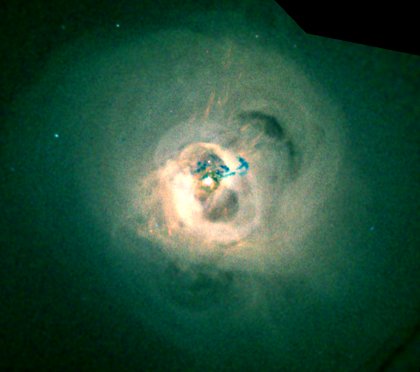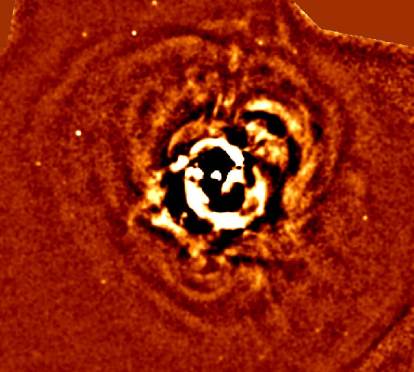Main page
Publications
APOD pictures
Press releases
Research of Jeremy Sanders
I am based at the Max Planck
Institute for Extraterrestrial Physics (MPE), working in
the High Energy
Astrophysics Group. I was a postdoctoral researcher working in
the X-ray Group at
the Institute of
Astronomy, University of
Cambridge, UK.
My work is mainly on the topic of clusters of
galaxies. Galaxy clusters are the largest objects in the universe
which are held together by gravity. They consist of hundreds to
thousands of galaxies (each of which contains many billions of stars),
moving through a very hot diffuse gas or plasma. This gas is known as
the intracluster medium (ICM) and has a temperature of 10s of
millions of degrees C. The hot gas emits X-rays which we can observe
from observatories orbiting the Earth such as Chandra and XMM-Newton.
Some of the interesting scientific questions I am trying to address
involve the interaction of the central supermassive black holes which
lie in cluster cores with the surrounding intracluster medium. The
intracluster medium in the cores of galaxy clusters should be cooling
soon as it is emitting a lot of energy from X-rays. The problems I am
working on include, How much gas is cooling in clusters?,
Do the black holes stop the cooling of the ICM?, If they
do, how do they stop cooling? To answer these questions I look at
the nearest, brightest galaxy clusters in detail. Here is some
information on recent research.
The Perseus cluster
The Perseus cluster (pictured) is the brightest cluster of galaxies in
the sky when viewed in X-rays. This makes it an ideal target to study
the interaction of supermassive black holes with galaxy clusters, as
you get a lot of X-ray light from a cluster to analyse.
The bright dot at the centre of the images is the central supermassive
black hole. Above and below that you can see round darker regions in
the left image which are bubbles of energetic particles emitted by the
black hole. These radio bubbles (you can see the bubbles in radio
emission) push away the X-ray emitting gas, leaving you with holes in
the image. The two similar features further from the centre are
so-called fossil bubbles, which are believe to be old radio bubbles
which have detached themselves from the black hole and floated
outwards in the cluster. There are similar features seen in long observations.
The right image shows the small-scale variations seen in the
cluster. These ripple like features correspond to density variations
in the hot gas. We therefore think the are very low frequency
sound waves generated by the black hole as it blows the radio
bubbles. These may be some of the lowest notes in the Universe! For
more details see this press
release.
Links to some work I have been involved with that has appeared on
Astronomy Picture of the Day.
- 22nd August
2008, Active Galaxy NGC 1275
- 8th
December 2005, X-rays from the Perseus cluster core
- 12th
September 2003, A Note on the Perseus Cluster
- 28th
March 2002, Centaurus Galaxy Cluster in X-Rays
- 22nd
February 2001, 3C294: Distant X-Ray Galaxy Cluster
- 8th
December 2000, Abell 1795: A Galaxy Cluster's Cooling Flow
- 31st
October 2000, The Perseus Cluster's X-Ray Skull
- 15th June
2000, X-rays From The Perseus Cluster Core
Links to the press releases for some of the work I have been
involved with
-
Coma Cluster: Clues to the Growth of the Colossus in Coma
-
Hubble
sees magnetic monster in erupting galaxy
-
Perseus
cluster: Chandra proves black hole influence is far reaching
-
Chandra
"Hears" a Supermassive Black Hole in Perseus
-
Chandra
catches cannibal galaxy in the act
-
Chandra
Finds Most Distant X-ray Galaxy Cluster
-
Centaurus
Cluster of Galaxies: Vast Hot Gas Plume May Be A Passing
Attraction
-
Abell 1795:
A Cooling Flow In Galaxy Cluster Abell 1795
Other articles in the press
-
Booming
sound waves heat up galaxy cluster (New Scientist)
This is the personal page of Jeremy Sanders.
Imprint.
Privacy Policy.

